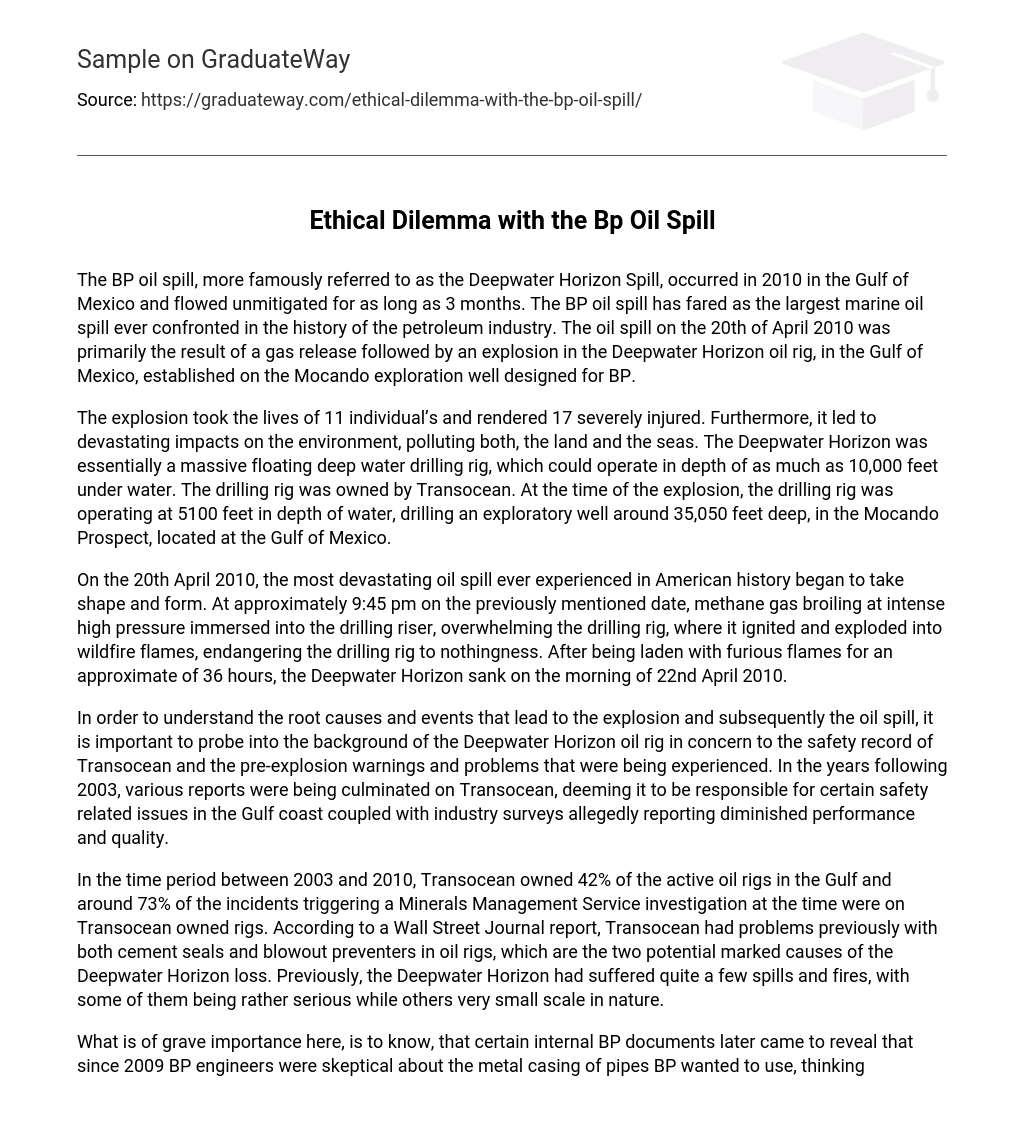The Deepwater Horizon Spill, also known as the BP oil spill, happened in 2010 in the Gulf of Mexico and lasted for 3 months. It is considered the biggest marine oil spill ever seen in the petroleum industry. On April 20, 2010, an explosion occurred on the Deepwater Horizon oil rig after a gas release. This rig was situated on the BP-designed Mocando exploration well in the Gulf of Mexico.
The explosion of the Deepwater Horizon, a drilling rig owned by Transocean, caused the loss of 11 lives and severe injuries to 17 people. It had catastrophic environmental consequences, polluting both land and sea. This event took place at a depth of 5100 feet in the Mocando Prospect in the Gulf of Mexico while the rig was drilling an exploratory well that was approximately 35,050 feet deep.
The largest oil spill in American history commenced on April 20, 2010 when a high-pressure methane gas entered the drilling riser, causing an explosion and fire on the drilling rig. After being consumed by flames for approximately 36 hours, the Deepwater Horizon sank on April 22, 2010.
In order to comprehend the explosion and oil spill, it is crucial to analyze the background of the Deepwater Horizon oil rig. This involves examining Transocean’s safety record as well as considering any previous warnings or issues before the incident occurred. Starting from 2003, several reports highlighted safety concerns in the Gulf coast related to Transocean. Furthermore, industry surveys indicated a decrease in performance and quality during that period.
From 2003 to 2010, Transocean possessed 42% of the operational oil rigs in the Gulf. Within this period, approximately 73% of incidents that prompted an investigation by the Minerals Management Service transpired on rigs owned by Transocean. The Wall Street Journal’s report indicated that Transocean encountered problems with cement seals and blowout preventers on their oil rigs, both of which can potentially contribute to a loss like that of Deepwater Horizon. Prior to the tragic incident, Deepwater Horizon had previously encountered various spills and fires, ranging from major incidents to minor ones.
What is of grave importance here is to understand that certain internal BP documents later disclosed that since 2009, BP engineers had doubts about the metal casing of pipes they intended to use, believing that there was a chance it could collapse under high pressure. By March 2010, the situation deteriorated as the drilling rig encountered issues such as the descent of drilling mud into the underwater oil deposit, unforeseen gas releases, a gas pipe falling into the well, and at least three documented occurrences of leaks in the blowout preventer fluid.
The mechanics at the rig expressed their worries and reported that the rig is constantly experiencing pressure from the gas and is making efforts to withstand it by offering resistance. Additionally, a confidential survey carried out by Transocean revealed that numerous workers at the rig had strong concerns regarding the operation and safety conditions. During the explosion, out of the 126 individuals present, 79 were employees of Transocean.
These workers believed that BP was prioritizing starting drilling operations instead of maintaining the rig, disregarding the equipment’s actual lack of reliability. Additionally, these workers feared losing their jobs if they voiced their concerns about the risky and daring actions being taken by BP. As a result, they submitted false data when asked to report on the rig’s operating conditions, distorting the perception of safety surrounding the rig.
Additionally, according to a report by ’60 minutes’, an accident that took place in March 2010 and was not reported at the time, revealed significant damage to the blowout preventer. On 25th May 2010, the ‘House Committee on Energy and Commerce’ released an investigation that highlighted several prominent warnings visible shortly before the explosion.
The detection of gas bubbles infiltrating the well was a remarkable sign indicating an imminent catastrophe and significant blowout. Initially, the leaking well’s gas was contained by dense drilling mud in the pipes. However, a BP official later instructed a worker to increase the pressure of gas on the well by adjusting the drilling pipe settings, driven by urgency to start the project. These combined factors contributed to an impending disaster. Considering various risks and safety concerns related to the well, it can be concluded that a major failure in maintaining its integrity, along with insufficient hydrostatic control and inadequate securing of blowout preventer equipment, primarily caused the explosion and oil spill.
On April 22nd, an oil slick was discovered in the former rig site, resulting in the release of approximately 4.9 million barrels of oil. This surpasses the previous record set by the Exxon Valdez spill in 1989. According to data from the Flow Rate Technical Group, around 53,000 barrels of oil leaked from the well until it was effectively sealed on July 15th.
The oil spill spread over an estimated area of 10,000 squared km. It affected the Delta National Wildlife Refuge, Breton National Wildlife Refuge, and the beaches of the Gulf National Seashore in Mississippi, Alabama, and Florida. The oil spill was also observed along the Louisiana coastline. Fortunately, the well was successfully capped on July 15, 2010. By July 30, the oil had dissipated more than anticipated.





